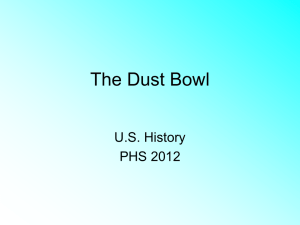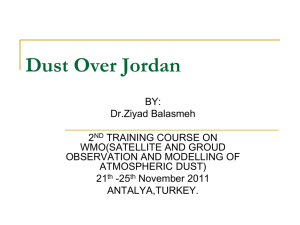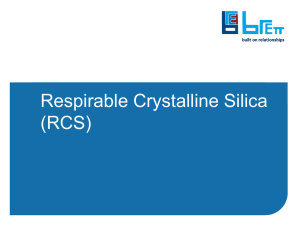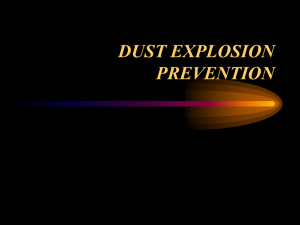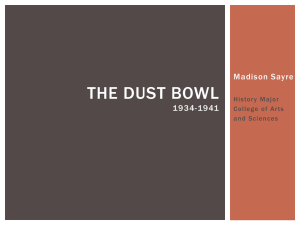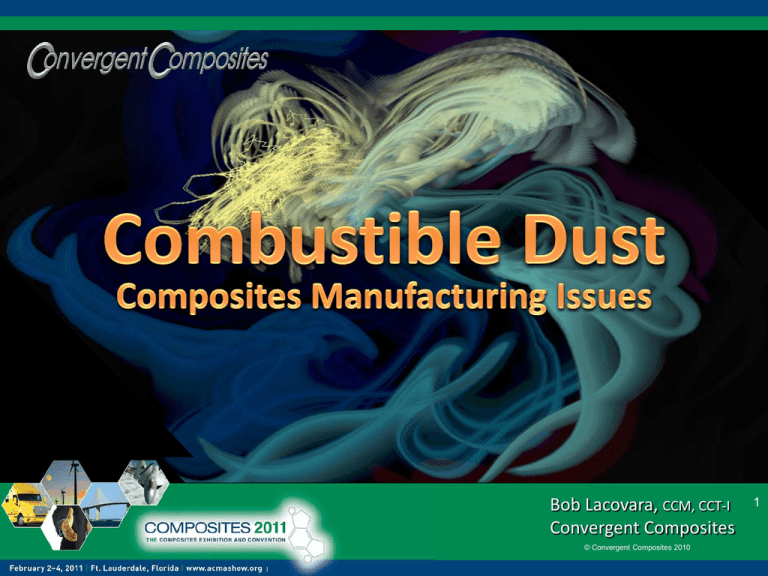
Bob Lacovara, CCM, CCT-I
Convergent Composites
© Convergent Composites 2010
1
U.S. Department of Labor
Occupational Safety & Health Administration
As a result of several catastrophic
dust explosion events OSHA issued
a national enforcement emphasis
on dust
© Convergent Composites 2011
2
U.S. Department of Labor
Occupational Safety & Health Administration
A series of composites plants
have had routine inspections
where dust issues were cited
or dust was a discussion item
© Convergent Composites 2011
3
What are the chances?
The risk of a composites plant
dust explosion has not changed,
nor have there been any recent
documented incidents.
However, the regulatory
emphasis elevates the technical
possibility of such an incident.
© Convergent Composites 2011
4
Combustible Dust Policy Institute:
• 50% of dust explosions involved a dust collector
• 10% of combustible dust incidents involved
ductwork
• Few combustible dust incidents
have to do with housekeeping
• Most combustible particulate
incidents occur inside process
equipment
© Convergent Composites 2011
5
What is a dust explosion?
© Convergent Composites 2011
6
Combustible Dust is a
combustible particulate
solid that presents a fire or
explosion hazard when
suspended in air or the
process-specific oxidizing
medium over a range of
concentrations, regardless
of particle size or shape
© Convergent Composites 2011
7
Explosion:
Rapid oxidation that results in a
sudden increase in gas volume
and temperature,
accompanied by
an overpressure
shock wave
© Convergent Composites 2011
8
Deflagration:
Propagation of a combustion zone
through a fuel-oxidizer mixture at a
rate less than the speed of sound and
capable of producing a significant
increase in pressure.
© Convergent Composites 2011
9
Defining the Terms
Flash Fire:
A rapidly moving, short duration
flame front resulting in
intense thermal radiation
© Convergent Composites 2011
10
Defining the Terms
Dust Explosion:
In plain English - The ignition of airborne
particles resulting in an explosion or a
deflagration.
© Convergent Composites 2011
11
How does a dust explosion occur?
© Convergent Composites 2011
12
Dust Hazard Basics
Dust Explosion Characterization
Primary Event
An occurrence where standing
dust is dislodged forming a small
dust cloud
• Sudden flush of air over a
dust laden surface
• Mechanical vibration
that dislodges dust
• Small localized explosion
© Convergent Composites 2011
13
Dust Hazard Basics
Dust Explosion Characterization
Primary Event
Secondary Event
An occurrence where standing
dust is dislodged forming a small
dust cloud
• Sudden flush of air over a
dust laden surface
• Mechanical vibration
that dislodges dust
• Small localized explosion
A large dust cloud is formed by
the primary event
• Ignition source ignites
dust cloud
• Large scale deflagration
occurs
• Catastrophic event
© Convergent Composites 2011
14
The Safety Issue
How Does a Dust Explosion Occur?
Event occurs that dislodges
a small amount of dust
© Convergent Composites 2011
15
The Safety Issue
How Does a Dust Explosion Occur?
Dust is exposed to
an ignition source
© Convergent Composites 2011
16
The Safety Issue
How Does a Dust Explosion Occur?
Small dust cloud ignites
© Convergent Composites 2011
17
The Safety Issue
How Does a Dust Explosion Occur?
Pressure wave dislodges
a large dust cloud
© Convergent Composites 2011
18
The Safety Issue
How Does a Dust Explosion Occur?
Large dust cloud ignites
© Convergent Composites 2011
19
The Safety Issue
How Does a Dust Explosion Occur?
Large Scale Deflagration Occurs
© Convergent Composites 2011
20
What are the conditions required
for a dust explosion?
© Convergent Composites 2011
21
Dust Explosion
Conditions for a Fire
Fuel
Ignition
Source
© Convergent Composites 2011
Oxidant
(Oxygen)
22
Dust Explosion
Conditions for a Dust Explosion
Fuel
Confinement
Mixing
Ratio
© Convergent Composites 2011
Oxidant
(Oxygen)
Ignition
Source
23
Dust Explosion
Mixing
Ratio
To ignite airborne dust the particle to air
concentration must be between the
upper and lower explosive level
(This ratio is different for various types of dust)
© Convergent Composites 2011
24
Dust Explosion
Effects of Dust Concentration
• Explosive pressure is a
function of concentration
• Higher concentrations are
easier to ignite
© Convergent Composites 2011
25
Dust Explosion
Effects of
Air Temperature & Humidity
• Temperature is generally not a factor
• Humidity may be a significant factor
• Hydroscopic nature of the dust
• High moisture content reduces potential
• Low humidity increases electrostatic
discharge potential (ESD)
© Convergent Composites 2011
26
Dust Explosion
Hybrid Mixtures - Dust + Vapor
At dust concentrations below
the minimum explosive
concentration, and at vapor
concentrations below the LFL,
a flammable hybrid mixture
can occur
© Convergent Composites 2011
27
How is dust characterized
in terms of hazard potential?
© Convergent Composites 2011
28
Dust Characterization
Hazard Determination
Minimum Ignition Temperature (MIT)
Dust Layer / Dust Cloud
The lowest temperature
of a hot surface which
will cause a dust
cloud to ignite
and propagate
flame
Expressed in 0F
© Convergent Composites 2011
29
Dust Characterization
Hazard Determination
Minimum Ignition Energy (MIE)
A measure of how sensitive an
explosible dust is to electrical
spark ignition. Gives guidance
on whether ignition by
electrostatic discharge
or process conditions
is likely to occur
in practice
© Convergent Composites 2011
Expressed in mJ
(milijoules)
30
Dust Characterization
Hazard Determination
Minimum Explosible Concentration (MEC)
The lowest concentration of
dust or powder that will
ignite on contact with
an ignition source and
propagate a dust
explosion
Expressed in g/m3
© Convergent Composites 2011
31
Dust Characterization
Dust Layer Thickness
• 1 mm thick - Potential for 10g/m3 concentration
• European standards test “smoldering” temperature
• 5 mm and 50 mm thick dust layers
• Thicker deposits require lower allowable
surface temperature
© Convergent Composites 2011
32
Dust Characterization
OSHA Guidelines:
In the absence of definitive test data
OSHA will seek compliance for an
acceptable limit of 1/32 in. (0.79 mm)
© Convergent Composites 2011
33
Dust Characterization
National Fire Protection Association
NFPA 654 - Use of Separation (6.2.3)
Allowable dust thickness is determined
with an engineering evaluation designed
to determine separation distances based
on the properties of materials handled,
type of operation, accumulations, building
design and surrounding exposures
© Convergent Composites 2011
34
Uniform Downward Hemispherical Diffusion Model
Ceiling or Overhead Beam
Concentrated Dust Source
1 ft.
1,786 g/m3
2 ft.
223 g/m3
3 ft.
66 g/m3
4 ft.
5 ft.
14 g/m3
© Convergent Composites 2011
28 g/m3
Dust Bulk Density = 0.359 g/cc
Thickness = 0.125”
Area = 1 ft2 35
Uniform Downward Linear Diffusion Model
Overhead Beams
Dust Bulk Density = 0.359 g/cc
Thickness = 0.125”
Area = 500 ft2
1 ft.
2 ft.
3 ft.
4 ft.
5 ft.
© Convergent Composites 2011
36
Diffusion Models Spreadsheet
© Convergent Composites 2011
37
© Convergent Composites 2011
38
Dust Explosion Prevention
General Principles
1. Reduce amount of dust (fuel) available
2. Avoid flammable atmospheres
3. Eliminate/control ignition sources
4. Provision against consequences of ignition
© Convergent Composites 2011
39
Dust Explosion Prevention
Reduce Dust Generation
Make Less Dust
• Improve product design to eliminate
cutting/grinding
• Improve cutting/grinding process
• Use wet trimming/water jet cutting
• Improve QC - Less re-work
© Convergent Composites 2011
40
Dust Explosion Prevention
Contain Dust Making Operations
Dust Capture
• Point capture at tool - Hoods, guards,
or suction devices
• Confine cutting-grinding-sanding to specific
dust making areas
• Operate in grinding booths/areas
• Segregate from general process
© Convergent Composites 2011
41
Dust Explosion Prevention
Maintain Dust Collection Systems
Routinely clean duct work and plenums
• Eliminating residual dust build-up
reduces fire hazard
• Eliminating residual dust build-up
increases system efficiency
© Convergent Composites 2011
42
Dust Explosion Prevention
Verify Grounding Continuity of
Flexible Hoses
Reduces static charge in system
Electrical Ground
© Convergent Composites 2011
43
Dust Explosion Prevention
Properly Ground Bags and
Collection Equipment
Electrical Ground
© Convergent Composites 2011
44
Dust Explosion Prevention
Isolate Dust Collection Equipment
From Personnel & Process
Best practice includes
reducing in-plant
exposure to
potential
hazards
© Convergent Composites 2011
45
Dust Explosion Prevention
Housekeeping
Periodically clean:
• Beams, rafters, girts
• Dropped ceilings
• Storage areas
• Behind partial panel walls
• Interior roof surfaces - booths/offices
• Areas where dust may accumulate
© Convergent Composites 2011
46
Dust Explosion Prevention
Revision of 654
Requires implementation of a planned
inspection process to determine dust
accumulation rates and determine
housekeeping frequency
© Convergent Composites 2011
47
Dust Explosion Prevention
Revision of 654
Establishes a Hierarchy of Cleaning Methods
• Vacuum cleaning
• Sweeping
• Water wash down
• Compressed air blow down
(only after other methods & with
protected electrical equipment)
© Convergent Composites 2011
48
Dust Explosion Prevention
Codes & Standards
Reference
OSHA
• PSM
regulation
• General Duty Clause 5(a)(1)
• 1910 Subpart S - Electrical installations
• 1910.94 – Ventilation requirements
• 1910.1200 - HazComm
© Convergent Composites 2011
49
Dust Explosion Prevention
Codes & Standards
Reference
National Fire Protection Association
• General - NFPA 654
• Facility Design Codes
• NFPA 68-69-70-77-499-650
• Life Safety Codes
• NFPA 101
• Building Codes – IBC
• NFPA 5000
© Convergent Composites 2011
50
Contact:
Bob Lacovara, CCM, CCT-I
Convergent Composites
blacovara@aol.com
215-257-1907
www.convergentcomposites.com
© Convergent Composites 2010
All rights reserved
51

